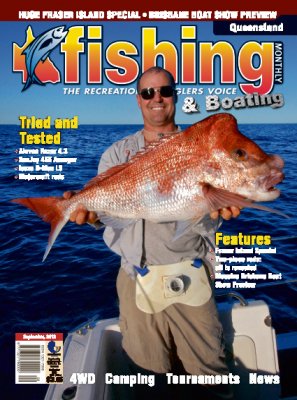Back to basics: two-piece or not two-piece by Kim Bain
 The factors influencing a person's choice between either a one-piece fishing rod or a two-piece fishing rod should get more discussion time than they do.
The factors influencing a person's choice between either a one-piece fishing rod or a two-piece fishing rod should get more discussion time than they do.
Early in my fishing career, as a kid in the 80s, all the rods that I used were one-piece. Accordingly, every time I used a two-piece rod I marvelled at their design and function. Some of those rods were horrors; the good ones were added to my collection.
I'm sure that I won't cover every rod available, however, my intent here is to mention the factors to consider when choosing whether you poke a one-piece rod out of the window on the drive home from the tackle shop, or if you stash a multi-piece rod in its tube into the boot.
If the introduction to this article makes you think that I'm a bit partial to multi-piece rods then you'd be correct. However, having travelled the world as a professional recreational angler who fished many different styles and techniques, I probably own 400 or so rods, yet only about 40 of them would be two-piece (and three or four piece).
Quite simply many rods are only available in a one-piece configuration. Multi-piece rods are available because they are easier to store and cart around.
FERRULE
The joins, or ferrules, in a multi-piece rod need to be carefully designed and tested to ensure that they aren't weak points where the rod will break - some ferrules are so well designed that the areas around the join are stronger than the rest of the rod.
As I mentioned earlier, it is not the aim of this article to compare the various types on modern ferrules. However I will comment that this century's glass-to-glass ferrules are far superior to the metal ferrules of my parent's youth.
Old timers would say that you may as well as buy a one-piece rod because when your two-piece rod's metal ferrule corroded together then you'd end up with a one-piece rod anyway. Back in those days the common types of ferrules created a flat-spot in a rod's power curve and detracted from the feel of the rod in your hand. Today the modern ferrules assemble and disassemble easily and in many cases you'll never know that they are there.
Back in the old days, when custom rods were more common, mainly because variety wasn't available off the shelf, it was often the backyard rod builder that cut and installed the ferrule in the rod blank before gluing on the butt components and binding on the guides and tip eyelet. Accordingly you could choose to either ferrule the rod in the middle or at the butt. These days it is more likely that the blank that you choose will come out of the factory already ferruled.
Most factory ferrule and multi-piece rod development probably came about via the fly rod market. In fact many before the fly rod refinements were incorporated into spin rods; spin rod anglers would build their spin rods on fly rod blanks just to use the refined joins available from fly rods.
PIECE LENGTH
Those early factory two-piece rods were nearly always ferruled at the halfway point. These days though, many high performance rods will have the ferrule closer to the butt. The butt is a stronger section of the rod blank so it stands to reason that this stronger region is the ideal place to design and incorporate a more durable join.
Rods like modern surf rods and fly rods are most often joined in the middle. Whereas offshore boat rods (bottom bashers, stand-up bent butt game rods, and some jig sticks) and longer lure casting rods (popper, spin rods and baitcaster flipping sticks) are some of the more common styles of multi-piece rod.